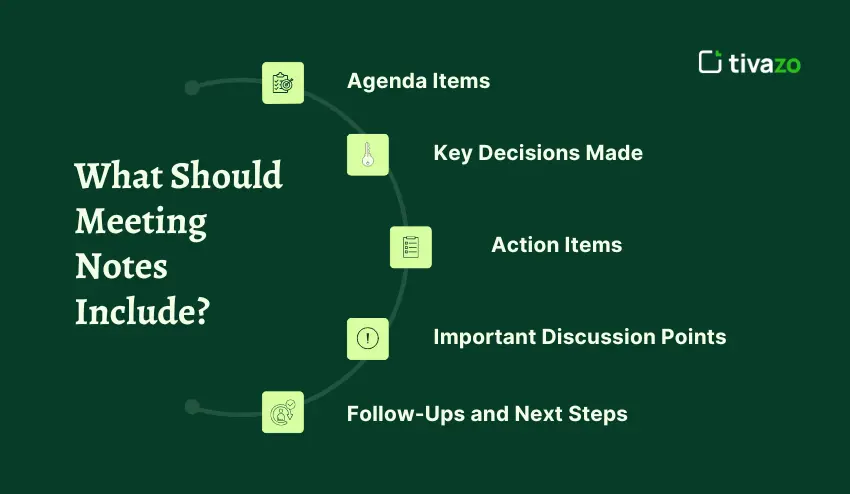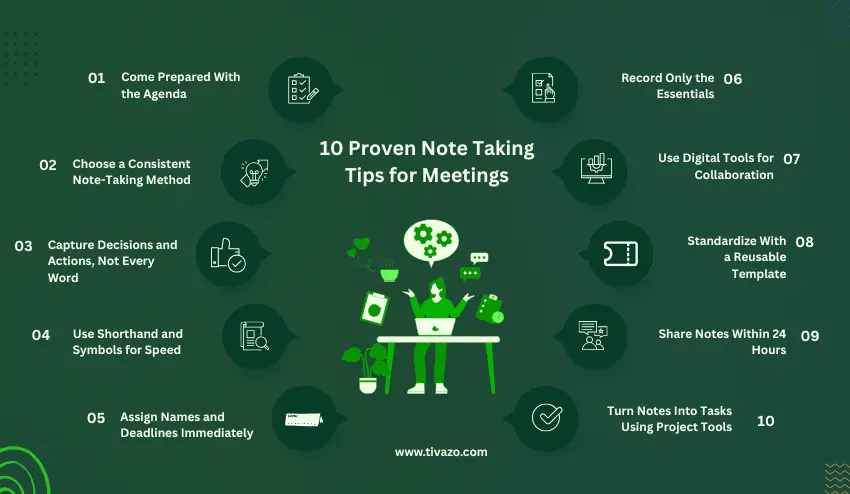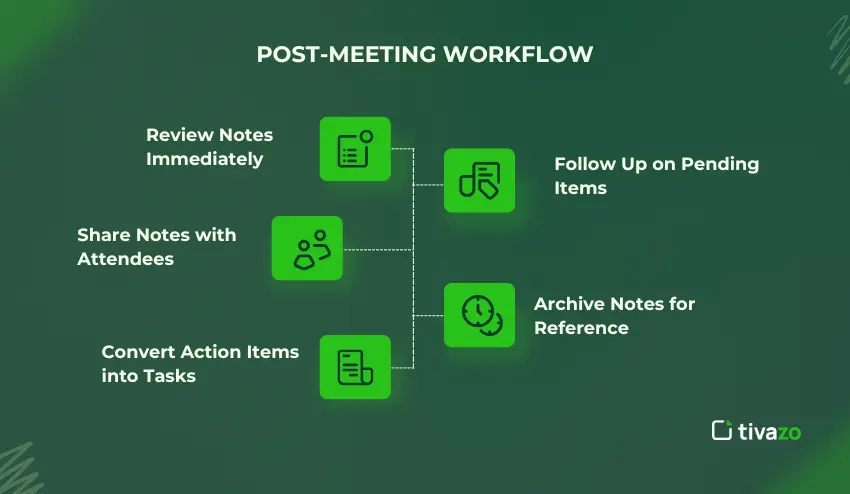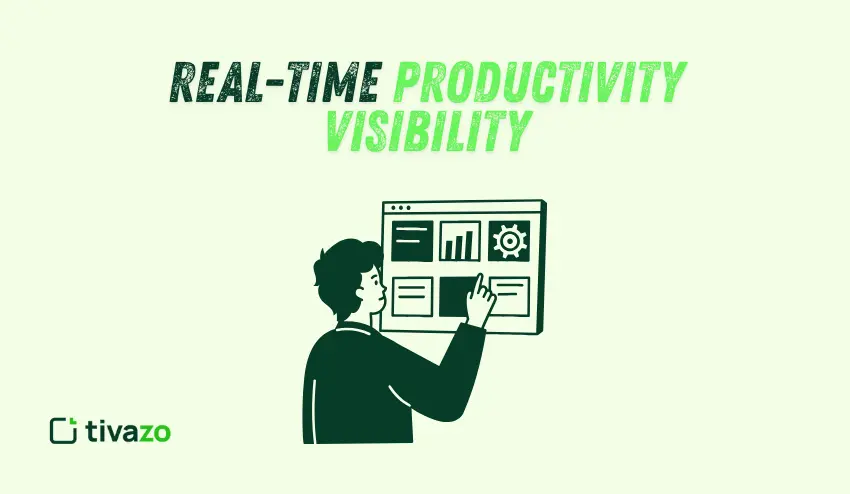Have you ever gone out of a meeting only to find that you cannot recall the main decisions or the course of action? You’re not alone. Research indicates that almost sixty percent of the time spent in meetings is wasted since individuals either make poor notes or do not make notes at all.
Good notes are not just the notes of what was said. They emphasize choices, delegate duties and transform extensive deliberations into action points. In their absence, meetings tend to be monotonous with the same issues being raised time and again.
This blog will discuss practical note taking tips for meetings that are applicable in real life situations. As a student or freelancer, or even a manager, these tips will assist you in capturing only what is important, be more organized, and make your meetings more fruitful.
At the end of it, you will know how to prepare, which techniques you can employ and even what tools will help you easier with note-taking.
What Should Meeting Notes Include?
To use the right note taking tips for meetings, it is good to know what to take note of. Meeting notes should not be transcript. Rather, they are supposed to recap the key items to ensure that all the people are aware of the consequences and roles.

1. Agenda Items
Each of the meetings begins with an agenda and your notes must reflect it. This facilitates relating discussions to the intended topics.
2. Key Decisions Made
Indicate the results of conversations. Was a new budget accepted by the team? Did leadership come to an agreement on the date of launching a product? List them out in a clear manner so that there is no confusion in future.
3. Action Items
The most important one, perhaps, is the part. Record the tasks which arise during the meeting and the individual in charge and the deadline. Example: Sarah will be ready with the Q4 sales report by Friday.
4. Important Discussion Points
It is not all details, but it is beneficial to have a summary of major arguments or views to provide the context. In this manner, an individual that was absent during the meeting can still be able to comprehend why a decision was made.
5. Follow-Ups and Next Steps
Each meeting results in another. Ensure that you have what must take place prior to the next meeting, or what will be re-examined.
10 Proven Note Taking Tips for Meetings
Good note taking tips for meetings can convert chaotic meetings into practical knowledge. With these strategies, you can be sure to capture what is important, be accountable and make the post-meeting follow-ups smooth.

1. Come Prepared With the Agenda
The important thing in taking notes is preparation. Go through the agenda before the meeting and emphasize on areas of your interest. It is always better to organize your notes beforehand so that you can write down important points. To illustrate, in case the agenda has an item about project update, draw a section that is titled Project Updates to scribble down project decisions and tasks effectively.
2. Choose a Consistent Note-Taking Method
A regular approach will make your note taking tips for meetings easier and simpler to read. Common approaches include:
- Cornell Method: Break up your page into cues, notes and summaries. Perfect in the discussions.
- Outline Method: This is the use of bullet points and subpoints to demonstrate hierarchy. Fit to hold formal meetings.
- Mind Mapping: Relates ideas in a graphic way, which is useful in brainstorming.
- Action-Item First: is task-oriented and responsibility-oriented. Convenient in meetings with a lot of hurry.
Choose and use one method and make your notes consistent and readable.
3. Capture Decisions and Actions, Not Every Word
Concentrate on results and not writing. Decisions that were recorded, tasks that were allocated and discussion points that were important and affected decisions. An example would be rather than saying that we discussed the marketing campaign, say: marketing campaign to be approved July 15; Maria to be in charge of assets by July 1. This makes your notes practical and in accordance with note-taking tips for meetings.
4. Use Shorthand and Symbols for Speed
Write faster: Use shorthand or symbols to take notes:
- → = action item
- ∆ = decision
- ? = follow-up needed
The use of abbreviations such as PM – project manager or FYI – for your information points saves time and still makes your notes readable.
5. Assign Names and Deadlines Immediately
It is always best to record the person in charge of what and at what time. An example: Alex, Prepare report of Q3 by Friday, Aug 1. Clarity of ownership leads to accountability and elimination of follow-ups, which is a major component of good note taking tips for meetings.
6. Record Only the Essentials
Do not use irrelevant information or dead air. Outcomes, responsibilities, or deadlines. Ask yourself: Would someone be perplexed because I have missed this? Only provide necessary information.
7. Use Digital Tools for Collaboration
The collaboration tools enable the easy capturing and sharing of notes in real-time:
- Google Docs: Team-based real-time editing.
- Concept: Organized notes containing connected databases.
- OneNote: Multi-device and rich formatting.
Online teamwork makes sure that all of them are on the same page, and it helps to take notes efficiently during meetings.
8. Standardize With a Reusable Template
A reusable template is time saving and consistent. Include:
- Agenda
- Key points
- Decisions
- Action items
- Follow-ups
Templates simplify the process of taking notes effectively besides strengthening the note taking tips for meetings in various sessions.
9. Share Notes Within 24 Hours
Share notes with the attendees quickly to keep the context and follow action items. Mark the best decisions first so that one can scan through quickly. Sharing in good time is a very important aspect of taking good notes during meetings.
10. Turn Notes Into Tasks Using Project Tools
Write down your notes in an action plan:
- Trello: Add action items with due dates.
- Asana: delegate duties and monitor deadlines.
- ClickUp: Add to your calendar to get reminders.
This step will make sure that meetings deliver results, and will complete the circle of effective note taking tips for meetings.
Note-Taking Methods: Which One Fits Your Meetings?
Not every meeting is similar and so is the method of taking notes. The right method can help you make your note taking tips for meetings more helpful. The most used techniques and their usage are as follows:
1. Outline Method
- What it is: Hierarchical bullet points, which are arranged around major topics and subtopics.
- Best: Firm meetings that have agendas.
- Advantages: Simple to read, fast to browse.
- Cons: May overlook links between ideas in case discussion is free-flowing.
2. Cornell Method
- What it contains: Page separated into three parts cues, notes, and summary.
- Best in: In-depth discussions or learning oriented meetings.
- Advantages: Stimulates review and memorization, excellent at learning or training.
- Cons: Requires a little more time to establish when using live meetings.
3. Mind Mapping
- What it is: Visual representation relating concepts to branches and sub-branches.
- Best: Brainstorming or creative.
- Advantages: Shows connections between subjects, visually appealing.
- Cons: May be messy when too many ideas are added.
4. Action-Item First Method
- What it is: It is much more task-centered, task-responsibility-centered and task-deadline-centered.
- Most suitable: Speedy meetings in which timely follow-up is vital.
- Advantages: Accountable, highly implementable.
- Cons: Smaller context, can be missing discussion nuances.
Comparison Table
| Method | Best Use Case | Pros | Cons |
|---|---|---|---|
| Outline | Structured meetings | Easy to scan, clear hierarchy | Misses free-flowing connections |
| Cornell | Training / detailed discussions | Encourages recall and review | Slightly slower to set up |
| Mind Mapping | Brainstorming / creative | Shows relationships visually | Can get cluttered quickly |
| Action-Item First | Fast-paced / decision meetings | Focus on accountability | Less context captured |
Best Tools for Meeting Notes
It is easier to adhere to your note taking tips for meetings by selecting the right tools. Digital tools enhance organization, teamwork, and accessibility particularly to remote or hybrid teams. The following are the best options:
1. Google Docs
- Best For: Live-time communication with several members.
- Advantages: Shareability, can be accessed on any device, live edits are supported.
- Cons: No offline capabilities; big documents may get disorganized.
- Hint: Prepare a common document on a per-meeting basis to ensure that all the notes are in a single place.
2. Notion
- Best For: Organized writing of notes and related databases.
- Advantages: Extremely flexible, can be integrated with calendars and task applications, rich media.
- Cons: May prove to be too difficult to learn; there is a learning curve.
- Hint: Have a template with items such as agenda, key points, and action items so that they are consistent.
3. Microsoft OneNote
- Recommended Use: Making comprehensive notes on devices.
- Pros: Notebooks, sections and pages are easily organized and it can be used offline.
- Cons: Not as collaborative as Google Docs to work in a team.
- Hint: Mark action points and choices so that you can scan through your notes.
4. AI-Powered Tools (Otter, Fireflies, MeetGeek)
- Use Recommendation: Meeting and discussion automatic transcription.
- Advantages: Records audiotape of every conversation, is searchable, and has the ability to summarize what was said.
- Cons: Can contain some errors and can be a cause of privacy issues when discussing the meeting space.
- AI tool tips: read AI transcript and underline action items to include note-taking tips for meetings.
AI Meeting Note Takers: Should You Use Them?
The use of AI Meeting note takers is increasingly popular because it will provide the option to record conversations automatically, summarize conversations and extract action items. They must be utilized as an addition to your note taking tips for meetings to save time and effort, but only when you are not afraid of the technology.
Benefits of AI Note Takers
- Automatic Transcription: It can recognize speech.
- Searchable Notes: You can save time in searching back through your notes for important points or decisions.
- Summarize: AI can summarize your notes to create shorter, more shareable summaries.
- Integration: Some AI tools can even be integrated with calendars, task management tools, and messaging systems.
Risks to Consider
- Problems with Accuracy: AI can make mistakes with technical jargon or with an accent, or when people speak too fast.
- Privacy Concerns: Sensitive data may sit on third-party servers.
- Dependence: After someone’s been too dependent on AI, active listening and engagement will have likely been diminished.
Best Practices
- Human Verification: Always review AI notes to make sure they are accurate.
- Highlight Action Items: AI can miss action items – so be sure to note tasks or deadlines as they pop up.
- Read Privacy Policies: Always check that participants know and agree to a recording and transcription.
Industry Examples & Mini Case Studies
Productivity in any industry can be revolutionized by effective note taking tips for meetings. By applying the systematic strategies, teams can not only record discussions, but also ensure that the decisions lead to action. Real life examples are as follows:
1. Tech Startup: Improving Remote Collaboration
The problem with unspoken responsibilities occurred in one of the mid-sized tech startups after weekly meetings. They cut back on follow up emails by 40 percent by using standardized note taking tips for meetings with agenda sections, decisions and action items, and using Google Docs. The employees could easily track activities and therefore make meetings more effective and practical.
2. Marketing Agency: Creative Brainstorm Sessions
Mind mapping was adopted by a marketing agency as one of the note taking tips for meetings. The team members could make visual connections of ideas in brainstorming through the digital mind maps in Notion. This not only did a better job at coming up with ideas, but also made the campaign planning and implementation well documented.
3. Corporate Finance Team: Decision Tracking
A finance department implemented accountability by using an action-item first approach. All decisions and tasks were documented using the best note taking tips for meetings, and in Asana, they had their owners and deadlines. This ensured that there was monitoring of critical financial approvals and no follow up was ignored.
4. Education & Training: Detailed Notes for Learning
The Cornell method had been employed by one of the universities in meetings and training sessions as their meeting note taking tips for meetings. There were notes with notes, major discussions and summaries. The decisions could be learned by new employees in a short period of time and repetitive problems could be solved faster improving overall efficiency.
Post-Meeting Workflow: Turning Notes Into Action
Taking notes is the first step. The real value is to convert your notes and discussions into action plans. Using the note-taking strategies for meetings helps ensure there is movement to results and discussion is not lost in time.

1. Review Notes Immediately
Write down your notes in the next 24 hours when the discussion is still hot. Decision identification, delegation and follow up. Action items should be specified in such a manner that they can be identified.
2. Share Notes with Attendees
Record with all participants. Transparency increases responsibility and ensures that everybody is aware of his or her responsibilities. Digital tools like Google Docs or Notion make sharing quick and collaborative, supporting your note taking tips for meetings.
3. Convert Action Items into Tasks
Move the work to project management such as Trello, Asana or ClickUp. Insert the deadline and the responsible. This is to make sure that the decisions are implemented and no decisions are lost in the cracks.
4. Follow Up on Pending Items
Set reminders for follow-ups. In the subsequent meeting, assess the pending activities to ensure continuity and responsibility is upheld. Structured follow-ups are a critical component of effective note taking tips for meetings.
5. Archive Notes for Reference
Store meeting notes in stores in one location. An effective archiving will enable your team to refer to the previous decision, see the situation of the current projects, and be more productive in general.
Common Mistakes to Avoid
Even with the best note taking tips for meetings, mistakes can reduce their effectiveness. The knowledge of the pitfalls will enable you to write more useful and better meeting notes.
- Attempting to enumerate everything as opposed to choices and action points.
- Failure to use the same approach of taking notes in meetings.
- Not taking action items or not setting owners and deadlines.
- Late distribution of meeting notes later than 24 hours.
- Lack of follow-ups and tasks.
Conclusion
Going through effective note taking tips for meetings can greatly increase productivity, accountability, and clarity. Making preparations ahead of the meeting, utilizing a uniform format, concentrating on key notes and actionable items, utilizing digital tools, and timely follow-up will assist in making sure that you can act upon all the meetings.
The creation of templates, reviewing of notes and use of structured strategies enable teams to be on track and minimize miscommunication. Regardless of whether you are a manager or a freelancer or a member of a bigger team, the mentioned tips will result in more effective and meaningful meetings.




